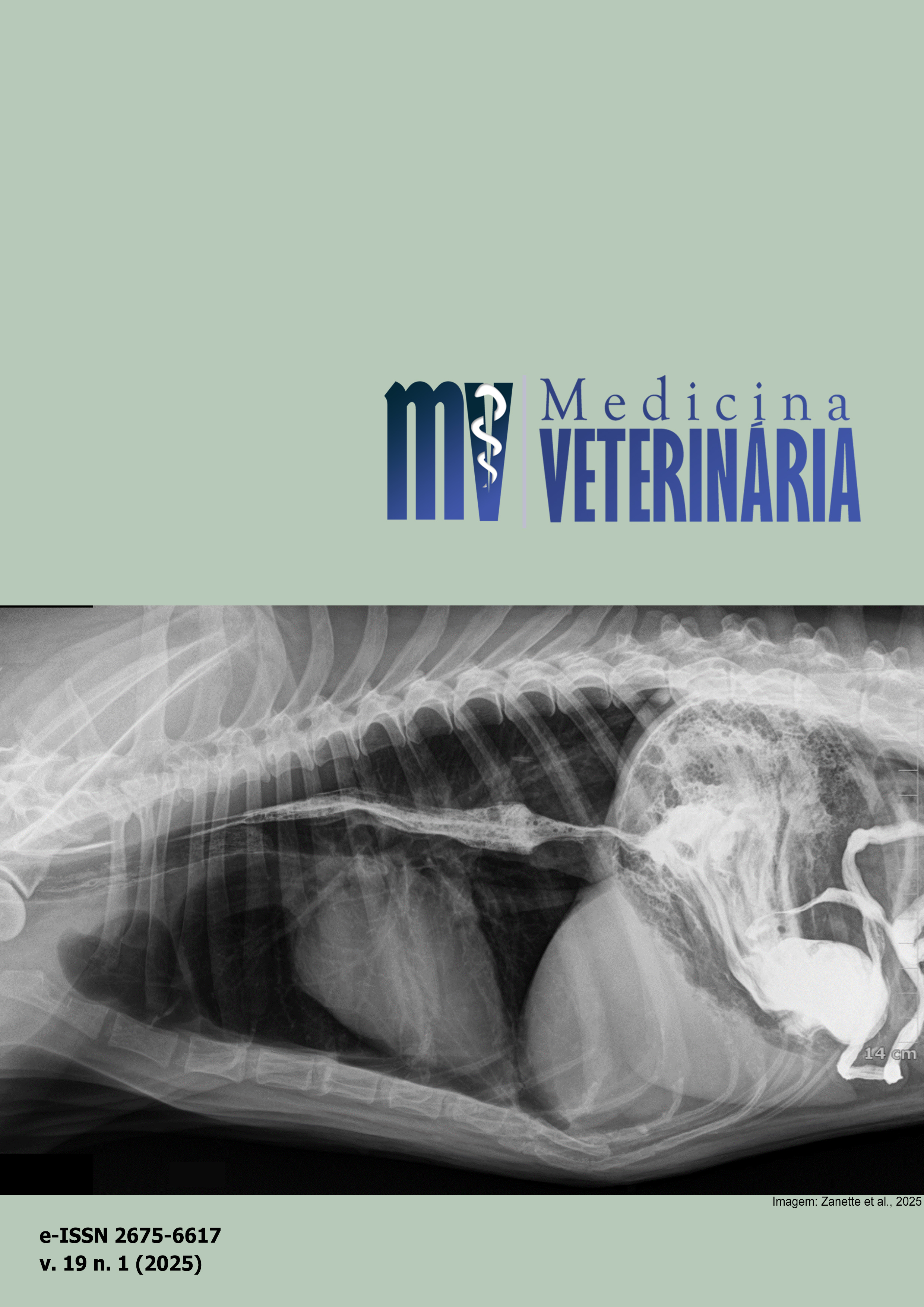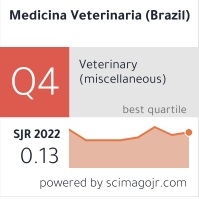Canine distemper in a crab-eating fox (Cerdocyon thous, Linnaeus, 1766) in the state of Santa Catarina, Brazil
DOI:
https://doi.org/10.26605/medvet-v19n1-6981Keywords:
infectious disease, wild canid, conservation medicineAbstract
Canine distemper, caused by the virus of the genus Morbillivirus (family Paramyxoviridae), affects domestic and wild hosts. The crab-eating-fox (Cerdocyon thous) is a susceptible wild canid and a possible reservoir of the disease. This report described clinical signs, complementary exams and necropsy findings in a free-ranging adult male infected with the virus in the state of Santa Catarina, Brazil. The animal was brought to the Núcleo de Estudos em Vida Selvagem at Universidade do Oeste de Santa Catarina showing apathy, dehydration, purulent eye secretion and motor incoordination. The following day the patient died due to cardiorespiratory arrest. Blood tests showed normocytic normochromic anemia, degenerative left shift, lymphopenia, monocytosis and hypoalbuminemia, while thoracic radiography demonstrated bronchopneumonia. The definitive diagnosis was confirmed by an immunochromatographic assay test to detect the viral protein. The animal suffered sudden death, presenting clinical, complementary exam and necropsy results similar to domestic dogs with canine distemper. Disease prevention involves implementing biosecurity measures and vaccinating domestic dogs. The description of this case is essential for monitoring the disease in wild animals, as they can become reservoirs leading to numerous interspecies infections, posing a risk to the conservation of several susceptible wild species.Downloads
References
Appel, M.J.G. Canine distemper virus. Virus infections of carnivores. Amsterdam: Elsevier Science, 1987. 2492p.
Brooks, M.B.; Harr, K.E.; Seelig, D.M.; Wardrop, K.J.; Weiss, D.J. Schalm's Veterinary Hematology. 7th ed. Nova Jersey: Wiley-Blackwell, 2022. 1.424p.
Cubas, Z.S.; Silva, J.C.R; Catão-Dias, J.L. Tratado de Animais Selvagens: medicina veterinária. 2a ed. Roca, 2014. 2492p.
Duque-Valencia, J.; Sarute, N.; Olarte-Castillo, X.A.; Ruiz-Saenz, J. Evolution and interspecies transmission of canine distemper virus-an outlook of the diverse evolutionary landscapes of a multi-host virus. Viruses, 11: 582, 2019.
Jorge, R.S.P.; Rocha, F.L.; May-Junior, J.A.; Morato, R.G. Ocorrência de patógenos em carnívoros selvagens brasileiros e suas implicações para a conservação e saúde pública. Oecology Australis, 14: 686-710, 2010.
Jucá, F.M.; Lima, B.M.C.; Chaves, R.N. Cinomose em canídeos silvestres no Brasil. Ciência Animal, 32(2): 136-148, 2022.
Mcvey, S.; Kennedy, M.; Chengappa, M.M. Microbiologia Veterinária. 3ª ed., Rio de Janeiro: Guanabara Koogan, 2016. 632p.
Oleaga, A. Canine distemper virus in wildlife in south-western Europe. Transboundary and Emerging Diseases, 69: e473–e485, 2022.
Sillero-Zubiri, C.; Hoffmann, M.; Macdonald, D.W. (eds). Canids: foxes, wolves, jackals, and dogs: status survey and conservation action plan. Status Survey and Conservation Action Plan. IUCN/SSC Canid Specialist Group. Gland and Cambridge: IUCN, 2004. 430p.
Sykes, J.E. Greene's Infectious Diseases of the Dog and the cat. 5th ed. St. Louis: Elsevier Science, 2022. 1818p.
Slaviero, M.; Ehlers, L.P.; De Lorenzo, C.; Zafalon-Silva, B.; Driemeier, D.; Pavarini, S.P.; Alievi, M.M.; Sonne, L. Anatomopathological and Immunohistochemical Apects of Distemper Virus in Crab-Eating-Foxes and Pampa-Foxes. Acta Scientiae Veterinariae, 47: 1632, 2019.
Stockham, S.L.; Scott, M.A. Fundamentos de patologia clínica veterinária. 2a ed. Rio de Janeiro: Guanabara Koogan LTDA, 2008. 729p.
Tilley, L.P.; Smith Jr, F.W.K.; Sleeper, M.M.; Brainard, B.M. Blackwell’s five minute veterinary consult: canine and feline. 7th ed. Hoboken: Wiley-Blackwell, 2021. 1730p.
Downloads
Published
How to Cite
Issue
Section
License
Copyright (c) 2025 Fabiane de Holleben Camozzato Fadrique, Andréia Buzatti, Andressa Hiromi Sagae, Edmilson Rodrigo Daneze, Raqueli Teresinha França, Jackson Fabio Preuss

This work is licensed under a Creative Commons Attribution-NonCommercial-ShareAlike 4.0 International License.
A Revista de Medicina Veterinária permite que o autor retenha os direitos de publicação sem restrições, utilizando para tal a licença Creative Commons CC BY-NC-SA 4.0.
De acordo com os termos seguintes:
Atribuição — Você deve dar o crédito apropriado, prover um link para a licença e indicar se mudanças foram feitas. Você deve fazê-lo em qualquer circunstância razoável, mas de nenhuma maneira que sugira que o licenciante apoia você ou o seu uso.
NãoComercial — Você não pode usar o material para fins comerciais.
CompartilhaIgual — Se você remixar, transformar, ou criar a partir do material, tem de distribuir as suas contribuições sob a mesma licença que o original.
Sem restrições adicionais — Você não pode aplicar termos jurídicos ou medidas de caráter tecnológico que restrinjam legalmente outros de fazerem algo que a licença permita.







